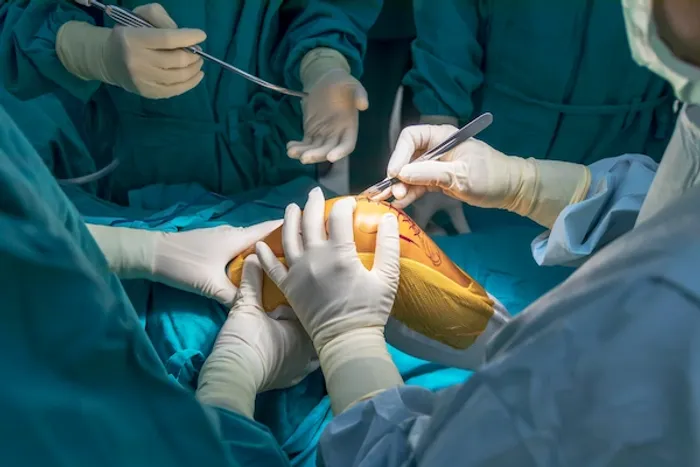Recent Trends In Total Knee Replacement
Explore the latest trends and advancements in total knee replacement surgery, including modern techniques, recovery tips, and improved patient outcomes.


Introduction
For decades, total knee replacement (TKR) has been a life-changing solution for millions suffering from severe arthritis pain. But if you imagine the procedure as it was 20 years ago, a major surgery with a long, painful recovery, it's time for an update. The field of joint replacement is undergoing a remarkable transformation, driven by technology and a deeper understanding of patient recovery. This guide will walk you through the most significant recent trends in total knee replacement, moving beyond a simple list to explain how these advancements work together to create a better experience from diagnosis to full recovery. Whether you're just beginning to consider your options or are preparing for surgery, understanding these innovations can help you have more informed conversations with your orthopedic surgeon about achieving the best possible outcome.
Why Knee Replacement is Evolving: The Drive for Better Outcomes
The fundamental goal of TKR remains the same: to resurface the damaged bones of the knee joint with artificial components, relieving pain and restoring function. However, the "how" has changed dramatically. Surgeons and engineers are continuously striving to improve three key areas: surgical precision, implant longevity, and the patient experience. The trends we see today are direct responses to past challenges. They aim to make the procedure less invasive, more predictable, and tailored to each individual's unique anatomy, ultimately leading to a faster, less painful recovery and a knee that feels more natural.
The Gold Standard: Understanding Traditional Total Knee Replacement
In a traditional TKR, the surgeon makes an incision over the knee, moves muscles and tendons aside, and removes damaged cartilage and bone from the end of the femur (thigh bone) and top of the tibia (shin bone). Metal components are then cemented or pressed into place, and a medical-grade plastic spacer is inserted between them to create a smooth gliding surface. While highly successful, this approach relied heavily on the surgeon’s skill and manual instruments, which could sometimes lead to slight variations in alignment. It is this quest for consistent, perfect alignment that fuels many of the new advancements in knee replacement surgery.
Trend 1: The Robotic Revolution in the Operating Room
Perhaps the most talked-about recent trend is the adoption of robotic-arm assisted surgery. This isn't a robot operating autonomously; rather, it's a powerful tool that enhances the surgeon’s capabilities.
How Robotic-Arm Assisted Surgery Works
Prior to surgery, a 3D virtual model of your knee is created from a CT scan. The surgeon uses this model to pre-plan the ideal size, placement, and alignment of your implant specific to your anatomy. In the operating room, the system provides real-time data and feedback. The surgeon guides the robotic arm, which has a high-speed burr, but the system creates a virtual boundary that prevents the removal of bone outside the pre-defined plan. This ensures an unparalleled level of accuracy.
Benefits of Robotic Assistance: Precision and Predictability
The primary benefits of robotic knee surgery are precision and predictability. Studies have shown that robotic assistance can lead to more accurate alignment of the implant, which is crucial for the long-term stability and function of the new joint. Better alignment can reduce uneven wear on the plastic spacer, potentially increasing the lifespan of the implant. For patients, this often translates to a knee that feels more balanced and natural, with some studies suggesting it may contribute to a faster initial recovery. If your condition requires such precise intervention, consulting a specialist, for instance, through an online ortho consultation with Apollo24|7, can be a good first step to understand if you are a candidate.
Consult an Orthopaedic Surgeon for the best advice
Trend 2: Personalised Knee Replacement with Patient-Specific Instrumentation (PSI)
Personalisation is a major theme in modern medicine, and knee replacement is no exception. Patient-Specific Instrumentation (PSI) is a key player in this space.
The PSI Process: From MRI to Custom Guides
Similar to the robotic process, PSI begins with an MRI or CT scan of your knee and, sometimes, your hip and ankle to assess your overall leg alignment. This data is sent to a manufacturer, which creates custom 3D-printed plastic guides that fit perfectly onto the unique contours of your bones. During surgery, the surgeon uses these custom guides instead of standard ones to make precise bone cuts, ensuring the implant aligns with your natural anatomy.
PSI vs. Robotic: What’s the Difference?
While both aim for precision, the key difference lies in execution. PSI provides a custom roadmap (the guides) for the surgery, while robotic assistance offers active guidance and boundary control during the procedure. PSI can potentially reduce operating time and may eliminate the need for the intramedullary rod used in traditional surgery, which can reduce blood loss. The choice between personalised knee replacement with PSI and robotic assistance is a detailed discussion to have with your surgeon based on their expertise and your specific needs.
Trend 3: Advanced Implant Materials for Long-Lasting Results
The components themselves are also getting smarter and more durable. The focus is on creating implants that last longer and function more like a natural knee.
Highly Cross-Linked Polyethylene: Combating Wear and Tear
The plastic spacer (polyethylene) is often the limiting factor in an implant's lifespan. When it wears down, particles can cause inflammation and lead to loosening of the implant, a primary reason for revision surgery. The development of highly cross-linked polyethylene has been a game-changer. This material is treated to make it extremely wear-resistant, significantly reducing particle generation. For younger, more active patients, this means a much-reduced risk of needing a second surgery later in life.
Gender-Specific and Kinematic-Aligned Implants
The one-size-fits-all approach is fading. Implants now come in a wider variety of sizes and shapes to better match different anatomies. Some designs account for typical anatomical differences between men and women. Furthermore, the philosophy of alignment is evolving. While traditionally aimed for a mechanically neutral leg every time, "kinematic alignment" seeks to restore the knee’s unique natural alignment and soft-tissue balance, which many surgeons believe leads to a more natural feeling knee with better range of motion.
Trend 4: Rethinking Recovery: Enhanced Pain Management and Rapid Recovery Protocols
Surgery is only half the battle; recovery is equally important. Modern protocols have drastically changed the post-operative experience.
Multimodal Analgesia: Moving Beyond Heavy Opioids
Gone are the days of relying solely on opioid pain medications, which cause significant side effects like nausea, constipation, and drowsiness. Today, pain management after TKR uses a "multimodal" approach. This involves using a combination of non-opioid medications (like acetaminophen and anti-inflammatories) and long-acting nerve blocks administered during surgery. This strategy targets pain through multiple pathways, providing better relief with far fewer opioid-related side effects, allowing patients to get up and move sooner.
The Shift to Outpatient and Short-Stay Knee Replacement
Due to improved techniques and pain control, what was once a 3-5 day hospital stay is now often a 1-night stay or even an outpatient knee replacement procedure performed in an ambulatory surgery center. Candidates for outpatient surgery are typically healthier individuals with strong home support. This shift is not just about convenience; it reduces the risk of hospital-acquired infections and allows patients to begin their recovery in the comfort of their own homes. If you experience unexpected pain or swelling during recovery, a quick online consultation with a doctor on Apollo24|7 can provide timely advice.
The Combined Effect: What These Trends Mean for You
Individually, these trends are impressive. Together, they create a synergistic effect. A robotically-placed, personalised implant made from advanced materials, combined with a rapid recovery protocol, offers the potential for a surgery that is safer, less painful, and more successful than ever before. Patients are experiencing shorter recoveries, better functional outcomes, and implants designed to last a lifetime of activity.
Conclusion: Taking the Next Step Toward a Pain-Free Life
The landscape of total knee replacement has been reshaped by innovation. The recent trends we've explored, from robotic assistance and personalised planning to advanced implants and accelerated recovery, collectively represent a monumental leap forward in patient care. These advancements are not just about surgical technique; they are about improving the entire human experience of regaining mobility and freedom from pain. If knee arthritis is holding you back, there has never been a better time to explore your options. Armed with this knowledge, you can confidently engage with an orthopedic specialist to discuss whether a modern total knee replacement is the right path for you. Take the first step toward a more active, pain-free life by seeking a consultation.
Consult an Orthopaedic Surgeon for the best advice
Consult an Orthopaedic Surgeon for the best advice

Dr. Anil Pradeep Jadhav
Orthopaedician
23 Years • MBBS MS (Ortho)
Nashik
Apollo Hospitals Nashik, Nashik
(25+ Patients)
Dr. Anil Sharma
Orthopaedician
42 Years • MBBS, MS Orthopedics
New Delhi
AAKASH MEDSQUARE, New Delhi

Dr. Manoj Dinkar
Orthopaedician
15 Years • MBBS, Dip (Orthopaedics)
New Delhi
THE DOCTORS NESST, New Delhi

Dr. Mriganka Ghosh
Orthopaedician
11 Years • MD (Physician), DNB (Orthopaedics)
Howrah
Dr Mriganka Mouli Ghosh, Howrah

Dr. Pradeep Lucas
Orthopaedician
7 Years • MBBS, Diploma in Orthopaedics, Fellowship in DFSI
Bengaluru
Revival Multispeciality Clinic, Bengaluru
Consult an Orthopaedic Surgeon for the best advice

Dr. Anil Pradeep Jadhav
Orthopaedician
23 Years • MBBS MS (Ortho)
Nashik
Apollo Hospitals Nashik, Nashik
(25+ Patients)
Dr. Anil Sharma
Orthopaedician
42 Years • MBBS, MS Orthopedics
New Delhi
AAKASH MEDSQUARE, New Delhi

Dr. Manoj Dinkar
Orthopaedician
15 Years • MBBS, Dip (Orthopaedics)
New Delhi
THE DOCTORS NESST, New Delhi

Dr. Mriganka Ghosh
Orthopaedician
11 Years • MD (Physician), DNB (Orthopaedics)
Howrah
Dr Mriganka Mouli Ghosh, Howrah

Dr. Pradeep Lucas
Orthopaedician
7 Years • MBBS, Diploma in Orthopaedics, Fellowship in DFSI
Bengaluru
Revival Multispeciality Clinic, Bengaluru
More articles from General Medical Consultation
Frequently Asked Questions
What is the main advantage of robotic knee replacement surgery?
The primary advantage is enhanced precision. The robotic system helps the surgeon execute a pre-operative plan with exceptional accuracy, leading to better implant alignment, which can improve the knee's function and longevity.
How long does a modern knee replacement typically last?
With advanced implant materials like highly cross-linked polyethylene, modern knee replacements are very durable. Studies show that over 90% of implants are still functioning well after 15 years, and many are expected to last 20 years or more.
Am I too young for a knee replacement?
The decision is based on your level of pain and disability, not solely on age. With longer-lasting implants, knee replacement surgery for younger patients is more common than ever. The goal is to restore quality of life, and if non-surgical treatments are no longer effective, age alone should not be a barrier.
What is the recovery time for a minimally invasive TKR?
While recovery varies, many patients walk with assistance the day of surgery. You may use a walker for 2-4 weeks, then a cane. Driving is often possible by 4-6 weeks, and a return to most daily activities occurs within 3 months. Full recovery with strengthened muscles can take 6-12 months.
Is personalised or robotic knee replacement covered by insurance?
In most cases, yes. The implant and the surgical procedure itself are typically covered by insurance the same way a traditional knee replacement is. However, it's crucial to check with your specific insurance provider and hospital to understand any potential additional costs.




